Will Banks' Excess Reserves Fuel a New Monetary Crisis?
Stock-Markets / Financial Crisis 2017 Mar 04, 2017 - 06:49 PM GMT Don't look now but inflation and a new gold rush might be in our future
Don't look now but inflation and a new gold rush might be in our future
Introduction: Professional investors are selling stocks and buying gold. Small investors are buying stocks and neglecting gold. While the bulk of attention has gone to the stock market thus far this year, gold is up 7.2% and the Dow Jones Industrial Average is up 6.2%. What is going on? In this month's issue we explore what the professional investors might know that small investors are missing?
"Banks in the United States have the potential to increase liquidity suddenly and significantly – from $12 trillion to $36 trillion in currency and easily accessed deposits—and could thereby cause sudden inflation. This is possible because the nation’s fractional banking system allows banks to convert excess reserves held at the Federal Reserve into bank loans at about a 10-to-1 ratio. Banks might engage in such conversion if they believe other banks are about to do so, in a manner similar to a bank run that generates a self-fulfilling prophecy. . . What potentially matters about high excess reserves is that they provide a means by which decisions made by banks – not those made by the monetary authority, the Federal Reserve System – could increase inflation-inducing liquidity dramatically and quickly." – Christopher Phelan, economist, Minneapolis Federal Reserve
It has been an enduring mystery to many why the enormous amount of money created by the Federal Reserve in the wake of the 2008 crisis to bail out the imperiled financial system never translated to a general price inflation. After all, as Milton Friedman lectured us, "inflation is always and everywhere a monetary phenomenon." So why didn't the enormous amount of money created by the Fed during its quantitative easing program – some $3.5 trillion pumped into American commercial banks to purchase mortgage-backed securities and Treasury paper – launch double-digit price inflation, or worse?
The answer, as it turns out, lies in a little discussed and understood line item on the Fed's balance sheet labelled "Reserve balances with Federal Reserve Banks," or "excess reserves" as it is called in the banking trade. Up until recently, the excess reserve mechanism operated quietly in the background with little in the way of public notice. A quick calculation tells us though that nearly 70% of the $3.5 trillion three-phase QE program made its way back to the Fed in the form of excess reserves. This recycling program amounted to little more than a thinly-disguised sterilization of Wall Street's bailout in order to delay the inflationary dangers it might have generated.
Now, as you are about to see, we could be in the early stages of a new and little understood monetary crisis. The massive amount of capital parked at the Federal Reserve as excess reserves is being steadily withdrawn by the commercial banks and loaned to businesses and consumers with notable effect. About $700 billion of the $2.7 trillion pool of money on deposit at the Fed has already been redeployed by the commercial banks. In turn, the money supply has begun to rise, and most notably this past January (2017) the producer price index registered a surprising nearly double-digit 8% annual increase. As it turns out, the inflation created by the Fed's quantitative easing program seems only to have been put in temporary abeyance. The full effect is yet to be determined.
(Note: In the final two sections of this analysis, we provide some insight as to the most likely outcomes for both the economy and the gold and silver markets if the present monetary trends continue. Hint: Some of the parallels between the present and the 1970s are striking and unmistakable.)
The process for dollar monetization, as Mr. Phelan suggests, has been fundamentally altered and this new web page offers a venue for monitoring those changes. Few are aware of the nuances with respect to the causes in this new monetary order, and most, even financial veterans, at the moment see only the effects. Below we connect the lines between cause and effect, and in so doing update the rationale for gold and silver ownership to include the possibility of a new inflationary, or perhaps stagflationary, era.
Excess Reserves of Depository Institutions
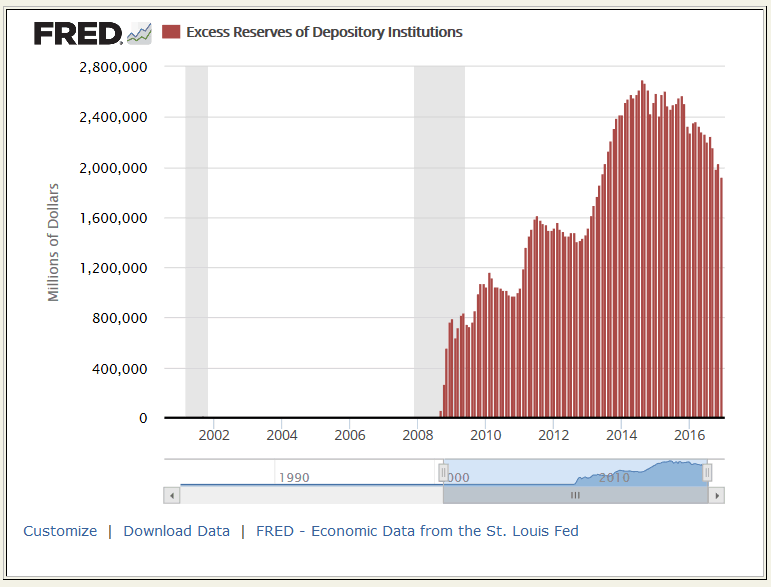 |
Prior to the 2008-2009 economic meltdown and subsequent Federal Reserve led Wall Street bailout, commercial bank excess reserves stood at a meager $1.5 billion. Post-bailout, that figure rocketed to $2.7 trillion. Excess reserves now stand at roughly $2 trillion – a $700 billion decline from the top in a period of a little over two years. The huge overhang of excess reserves, as explained above, is a residual of the Federal Reserve's quantitative easing programs, which represents both danger and opportunity for the U.S. economy – opportunity in that their redeployment could lead to full recovery, and danger in that they could ignite instead a runaway inflation or stagflation.
Excess Reserves, One-Year Treasury Constant Maturity Rate,
Interest Rate on Excess Reserves
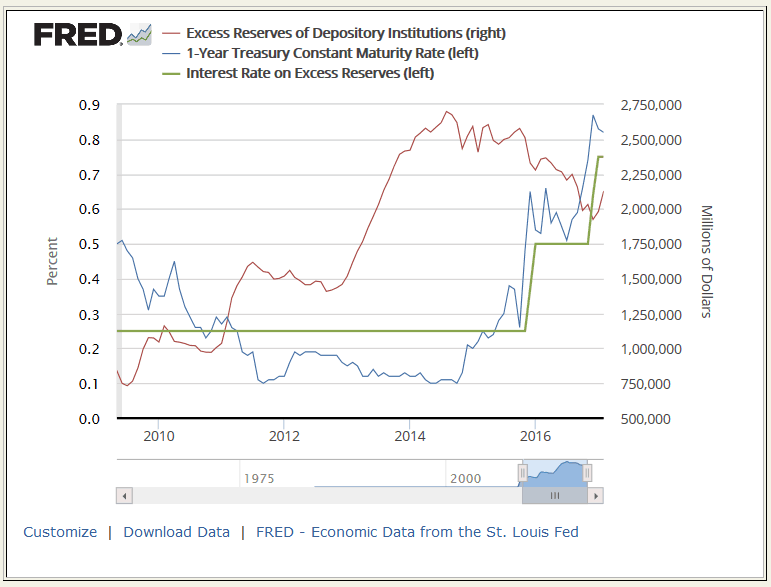 |
|---|
"The everyday tools of monetary policy are about to shift. The old standard tools of monetary policy taught in every intro econ class – open market operations, altering discount rates, and adjusting reserve requirements – all depend on banks that don't want to hold lots of excess reserves. When banks are holding a few trillion dollars in excess reserves, other policy tools are needed, and the Fed has already announced that monetary policy in the future will be conducted using the rate of interest that it chooses to pay on bank reserves as its primary tool for monetary policy, and secondarily by using its new reverse repo facility." – Timothy Taylor, Conversable Economics
As you can see in the chart above, the rules of the game changed in advance of the Fed's December, 2015 interest rate increase. The free market forces, unleashed by global selling of U.S. Treasuries, immediately began pushing rates higher. Most importantly, note in the chart that after 2015 the interest rates on one-year U.S. Treasuries – a proxy for interest rates in general – consistently traded above the static rate the Federal Reserve paid on excess reserves. The commercial banks now had strong incentive to begin converting excess reserves into new lending – an incentive that remains in play now.
________________________________________________________________________________________________________________
![]() Reader note: If you appreciate the kind of gold-based analysis you are now reading, you would probably find value in subscribing to our newsletter. It comes free of charge by e-mail and you can opt out of the service at anytime. Last, we will not deluge you with e-mails. Over 20,000 subscribe to this newsletter – one of the best and most widely read in the field. Never miss another issue. . . Please register here.
Reader note: If you appreciate the kind of gold-based analysis you are now reading, you would probably find value in subscribing to our newsletter. It comes free of charge by e-mail and you can opt out of the service at anytime. Last, we will not deluge you with e-mails. Over 20,000 subscribe to this newsletter – one of the best and most widely read in the field. Never miss another issue. . . Please register here.
________________________________________________________________________________________________________________
Excess reserves and bank credit
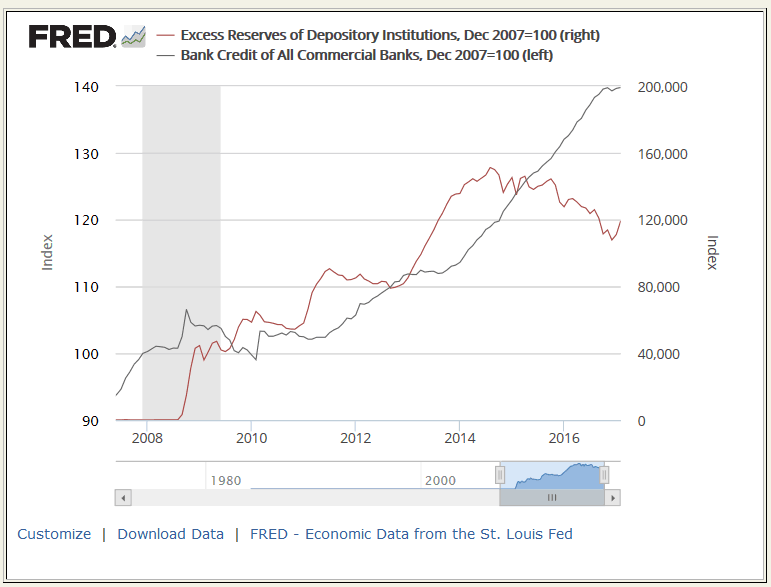 |
|---|
Capital in the modern fiat money system is borrowed into existence. For monetary policy to induce growth, consumers and businesses must be willing to borrow and banks must be willing to lend. Then and only then can growth and economic recovery begin. This chart demonstrates that banks have been successful in placing loans and that consumers and businesses are in fact willing to borrow.
There are three features in this chart worth special emphasis:
- First, the commercial banks steadily reduced excess reserves from October, 2015 when the Fed first suggested that it was about to raise interest rates.
- Second, bank credit* accelerated from early 2014 just before excess reserves began to flow from the Fed's balance sheet and back to the commercial banks. It gained momentum after the Fed actually raised its target for interest rates by .25% in December, 2015 and again in December, 2016 – the second and third time in a decade it moved to push rates higher.
- Third, there is a clear divergence between excess reserves and bank credit demonstrating the direct connection between the two. As excess reserves were drawn down, bank credit went up.
________________
* Bank credit consists of the aggregate in loans extended system-wide by U.S. commercial banks to businesses, individuals and the federal government.
Excess reserves and money supply (M2)
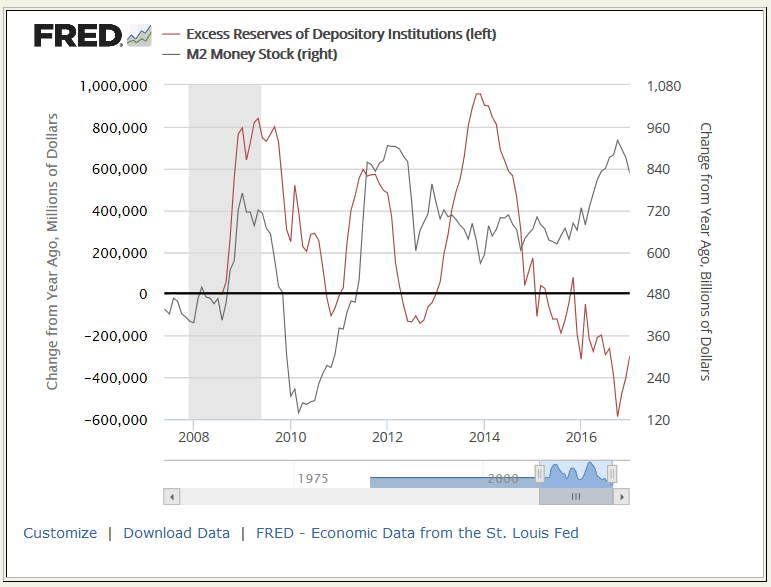 |
|---|
The redeployment of $700 billion in excess reserves has precipitated some interesting knock-on economic effects in other areas of the economy including a burgeoning money supply. Note the divergence in the chart above beginning in 2014. As excessive reserves are drawn down, money supply goes up – a clear indication of the correlation between excess reserves, bank credit, the money supply. . . .and ultimately, inflation. Famed monetary economist Milton Friedman stated that there was an average 23-month lag between the creation of money and when it showed up as monetary growth in M2. It is interesting to note that the commercial banks' first drawdowns in excess reserves occurred in early 2014 and, right on schedule, by late 2016 M2 had registered a 7.6% annualized gain.
Excess reserves and the producer price index
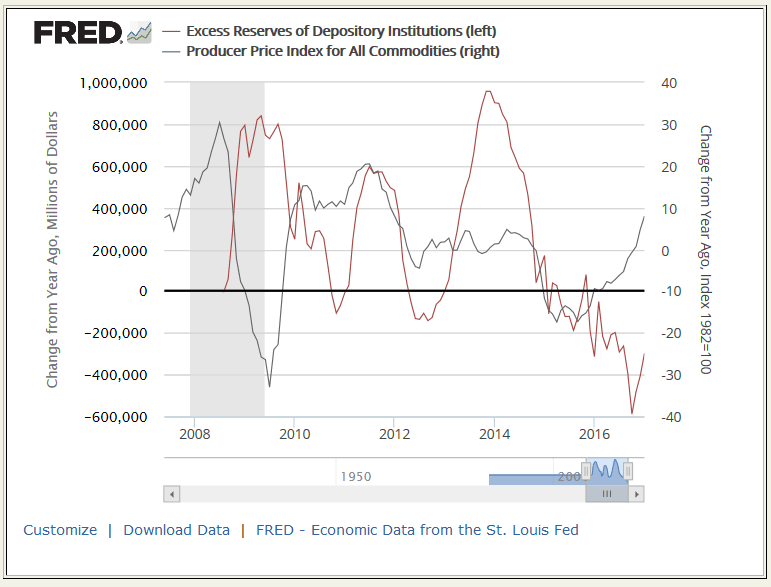 |
|---|
Of course, the ultimate end result of monetary policy is the effect on employment and prices. As you can see in this chart, producer (or wholesale) prices noticeably have begun to move higher. Note the divergence between excess reserves and producer prices beginning in December, 2015 – a clear indication of the correlation between the two charted data sets. Inflation's return has not received a great deal of attention in media financial reports. Once it again becomes a regular topic in the business news, consumer spending habits and investment patterns are likely to change.
Gold and the Producer Price Index
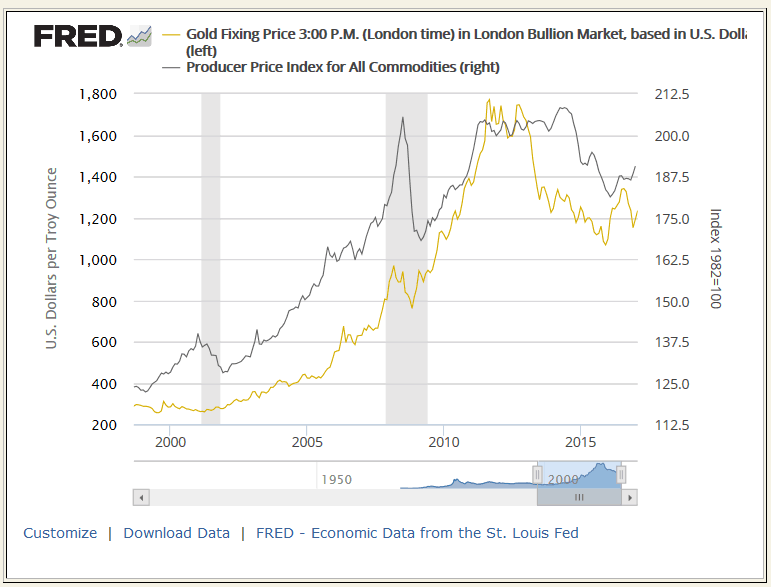 |
|---|
As pointed out in the previous newsletter on this subject (linked here), the price inflation that normally would have occurred as the result of the massive money printing scheme following the 2008-2009 financial crisis was sterilized and parked on deposit at the Federal Reserve in the form of excess reserves. As such, monetary inflation was quarantined for a time but not permanently sidelined. Now, as this series of charts demonstrates, that process has gone into reverse with quick and predictable results. Inflation has suddenly become an issue once again. The above chart shows the tight correlation since 2000 between gold and producer prices.
Looking to the future
"We had initially asked to pay interest [in 2006] on reserves for technical reasons. But in 2008, we needed the authority to solve an increasingly serious problem: the risk that our emergency lending, which had the side effect of increasing bank reserves, would lead short-term interest rates to fall below our federal funds target and thereby cause us to lose control of monetary policy. When banks have lots of reserves, they have less need to borrow from each other, which pushes down the interest rate on that borrowing — the federal funds rate." Ben Bernanke, The Courage to Act
Though it is too early to know with any certainty whether or not the tide has turned on the disinflationary economy, these changes in the monetary landscape are worth noting and monitoring. The telling part of the quote above is Ben Bernanke's concern about losing control of monetary policy. Since the crisis period he references, new threats to the Fed's preeminence have made their way into the monetary mix – the global liquidation of U.S. Treasuries which has had a direct effect on interest rates, and the commercial banks' drawdown of excess reserves which has had a direct effect on bank credit and the money supply.
As long as the Fed continues its policy of raising rates slowly and incrementally, the demand for U.S. Treasuries from overseas investors, including foreign central banks and governments, will remain subdued and, in fact, encourage liquidations. (China, for example, has liquidated roughly $1 trillion of its reserves over the past year.) Those liquidations, in turn, will continue to push rates higher in a kind of self-reinforcing feed-back loop. As for the future flow of excess reserves out of the central bank, the top commercial banks – all publicly owned – have as their primary mission the pursuit of profit in the best interest of their stockholders. As long as they are able to receive a consistently higher interest rate on their lending by drawing down their excess reserves, it is their responsibility to do so.
The only way for the Fed to interfere in both processes would be to get ahead of the interest rate curve by consistently pushing the fed funds rate above the rate established in the free market. To do so at this juncture, however, would send the wrong signal to the financial markets and would kill any semblance of recovery already set in motion. In addition, it would thwart the Fed's own attempt to counter disinflationary/deflationary trends at work in the U.S. economy.
In short, the baton has clearly passed, at least for the time being, to the commercial banks and global sellers of U.S. debt. The former will be a key determinant in money creation and the latter a key determinant in setting interest rates. When seen in this context, Mr. Bernanke's concerns about the Fed losing control of monetary policy appear to have been warranted.
At the moment investors are focused on the political aspects of the "reflation trade" as it is dubbed by the mainstream media, i.e. the fiscal and tax policies proposed by the Trump administration. These policies though come with a long fuse. It will take many months for the Trump administration to push its agenda through Congress (if at all). After that, it will take many more months for any resulting legislation to be implemented (particularly in the case of fiscal spending), and more time still before it actually takes effect in the economy.
In the meantime, as the sequence of charts above demonstrates, the excess reserves situation and related activity of the Federal Reserve System present a more immediate and direct avenue to reflation of the economy. In fact, the effects of that effort are already being felt.
Gold's role in all of this – "No one questions its value."
In a recent World Gold Council interview, Alan Greenspan made the following comments on gold's portfolio role under an inflationary/stagflationary economic scenario:
"Significant increases in inflation will ultimately increase the price of gold. Investment in gold now is insurance. It’s not for short-term gain, but for long-term protection. I view gold as the primary global currency. It is the only currency, along with silver, that does not require a counter-party signature. Gold, however, has always been far more valuable per ounce than silver.
No one refuses gold as payment to discharge an obligation. Credit instruments and fiat currency depend on the credit worthiness of a counter-party. Gold, along with silver, is one of the only currencies that has an intrinsic value. It has always been that way. No one questions its value, and it has always been a valuable commodity, first coined in Asia Minor in 600 BC."
Gold is not like other assets that depend upon another individual or an institution’s performance for value. It stands alone, and as Greenspan states without mincing words: “No one questions its value.” It is for those reasons that gold protects wealth no matter the economic malady visited upon the economy – inflation, hyperinflation, disinflation, stagflation, runaway stagflation and deflation. It is the ultimate armchair investment – the one asset you can rely upon no matter what happens politically or economically.
That said, Greenspan believes stagflation and runaway inflation to be the two primary portfolio menaces that need to be hedged for the future. Here is what he said in that same World Gold Council interview:
"As productivity growth slows down, the whole economic system slows down. That has provoked despair and a consequent rise in economic populism from Brexit to Trump. Populism is not a philosophy or a concept, like socialism or capitalism, for example. Rather it is a cry of pain, where people are saying: Do something. Help!
At the same time, the risk of inflation is beginning to rise. In the United States, the unemployment rate is below 5%, which has put upward pressure on wages and unit costs generally. Demand is picking up, as manifested by the recent marked, broad increase in the money supply, which is stoking inflationary pressures. To date, wage increases have largely been absorbed by employers, but, if costs are moving up, prices ultimately have to follow suit. If you impose inflation on stagnation, you get stagflation."
Investors last tangled with these twin dangers in the 1970s. Here is one last chart, and an important one, that shows gold's performance superimposed over the producer price index during that period. As you can see, while producer prices increased 2.5 times, gold rose by nearly 21 times. This chart tells, at a glance, the value of diversifying with gold and goes to the heart of the point Dr. Greenspan is making. (The Dow Jones Industrial Average over the same period gained only about 16%.) I might add as a final caution that runaway inflations rarely come in like a lamb, but more like a lion – suddenly and with a full-throated roar. In that respect, the near double-digit 8% annual gain in wholesale prices this past January might have been a clear warning shot across the bow.
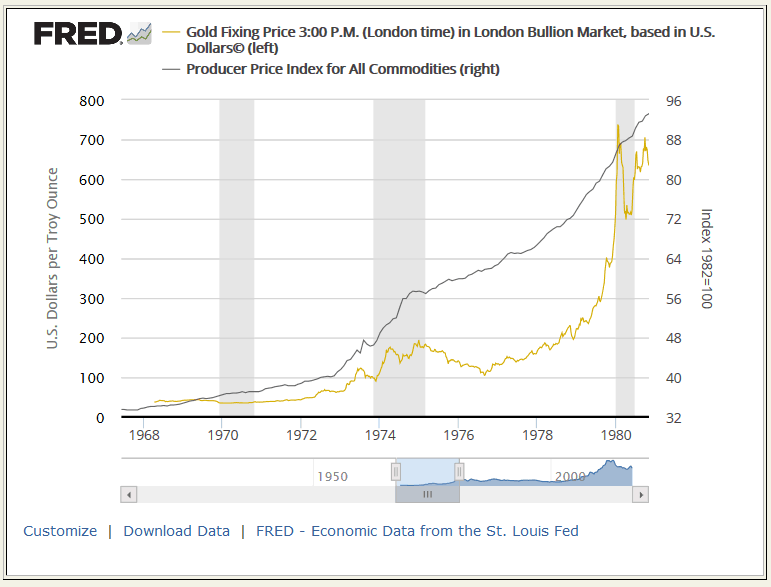 |
|---|
(Pictured above: Lydia gold stater, King Croesus, 561-541 BC, electrum (blend of silver and gold), ‘heavy’ stater specimens bring upwards of $30,000 in top grades. This specimen is from the British Museum collection and reproduced with permission.)
By Michael J. Kosares
Michael J. Kosares , founder and president
USAGOLD - Centennial Precious Metals, DenverMichael J. Kosares is the founder of USAGOLD and the author of "The ABCs of Gold Investing - How To Protect and Build Your Wealth With Gold." He has over forty years experience in the physical gold business. He is also the editor of Review & Outlook, the firm's newsletter which is offered free of charge and specializes in issues and opinion of importance to owners of gold coins and bullion. If you would like to register for an e-mail alert when the next issue is published, please visit this link.
Disclaimer: Opinions expressed in commentary e do not constitute an offer to buy or sell, or the solicitation of an offer to buy or sell any precious metals product, nor should they be viewed in any way as investment advice or advice to buy, sell or hold. Centennial Precious Metals, Inc. recommends the purchase of physical precious metals for asset preservation purposes, not speculation. Utilization of these opinions for speculative purposes is neither suggested nor advised. Commentary is strictly for educational purposes, and as such USAGOLD - Centennial Precious Metals does not warrant or guarantee the accuracy, timeliness or completeness of the information found here.
© 2005-2022 http://www.MarketOracle.co.uk - The Market Oracle is a FREE Daily Financial Markets Analysis & Forecasting online publication.



